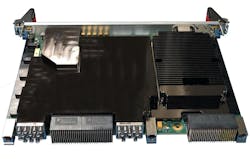SOSA draft industry standard picking up steam, and may lead to official open-systems standard in early 2021
NASHUA, N.H. – With a dizzying amount of cutting-edge technology, American warfighters have a decided edge against foes on the land, sea, or air. Government and industry partners are working together to ensure that technology is vendor-neutral and easily upgradable thanks the Sensor Open Systems Architecture (SOSA) Consortium.
The emerging SOSA standard -- overseen by The Open Group in San Francisco -- aims to enable military embedded systems designers to create new systems and make significant upgrades to existing systems much quicker than today's technologies allow.
SOSA experts Ken Grob, director of embedded computing at Elma Electronic in Fremont, Calif.; Mark Littlefield, vertical product manager - defense at Kontron in San Diego, Calif.; and Rodger Hosking, vice president and co-founder of Pentek in Upper Saddle River, N.J., gave the industry an update on SOSA Snapshot 3 late last month and how the emerging standard is expected to have a positive influence on embedded systems companies.
The trio of experts spoke about SOSA Snapshot 3 -- perhaps the last draft of the SOSA guidelines before they are approved as an official industry standard. SOSA Snapshot 3 represents the direction, thinking, and path the SOSA Consortium is taking as its members develop the standard. The discussion was part of a Military & Aerospace Electronics webcast on July 28.
Those in industry who would like to hear the entire SOSA Snapshot 3 Webcast can listen to the discussion online at https://event.on24.com/eventRegistration/EventLobbyServlet?target=reg20.jsp&partnerref=ws&eventid=2506403&sessionid=1&key=6B7156953D5DE9ED79947D0B05297688®Tag=&sourcepage=register.
The high-level goals of SOSA include openness and being platform- and vendor-agnostic while being aligned with Modular Open Systems Approach (MOSA) using standardized software and hardware. The consortium aims to leverage existing and emerging open standards and align with U.S. Department of Defense (DOD) service objectives. Finally, SOSA aims to keep technology affordable and adaptable.
According to the SOSA Snapshot 3 draft standard, “the goal of The Open Group SOSA Consortium is to develop open architecture at the right level for Communications (Comms), Electro-Optical/Infra-Red (EO/IR), Electronic Warfare (EW), Radar, and Signals Intelligence (SIGINT) supporting airborne, subsurface, and space.”
"Sensor management is such a big part of SOSA," says Kontron's Littlefield. "SOSA components -- plug-in cards -- are all expected to have sensor management capabilities. The key thing here is that sensor management is really a couple modules in the overall SOSA architecture."
Littlefield explains that SOSA system management has five basic concepts, which include discovery using automatic identification of and information collected by SOSA modules and includes hardware and software elements; configuration of SOSA modules and hardware elements; control allowing the capability to view or update parameters; health management monitoring, and security management.
The security module, Littlefield says, is a new for Snapshot 3 and uses authentication to ensure the module is suitable for a SOSA sensor; authorization to perform access control for privileged functions; and zeroization to erase any security-sensitive information.
Elma's Grob says that in addition to updates to system security, SOSA Snapshot 3 also includes updates to system management, new reference backplanes, data at rest definition, updates to power requirements, and conformance methodology.
"Much better interoperability is achieved by building systems from a reduced number of fully defined VPX slot and module profiles," Grob says.
Because SOSA standards have not been finalized yet, industry is producing products that are developed in alignment with SOSA.Pentek's Hosking says one such product is an OpenVPX backplane radio frequency (RF) and optical I/O board. One or both halves of the VPX P2 connectors are removed from the VPX backplane, and the backplane apertures accept housings for coaxial RF connectors and/or optical MT housings. This enables designers to configure one backplane to suit system needs.
"The nice thing about this concept is it allows a single backplane to be reconfigured by system integrator for different types of I/O," says Hosking. "[The] number of inputs and outputs, and different mixes of optical and RF signals. Each of the different configurations is specified within SOSA technical standard Snapshot 3."
Hosking continues, "Some other things that are required in real-time systems is timing signals. Ethernet is great for communications, but it doesn’t do well with low latency timing like synchronization signals and triggers. So, some new VITA module profiles allow different definitions of what's called 'user defined signals,' which are really not favored in SOSA. SOSA doesn't like 'user defined signals.' They'd prefer to have defined explicitly, and so SOSA requested a VITA profile be introduced that had general purpose LVDS pins for low latency signals."
While Kontron's Littlefield notes there aren't conformance policies listed in Snapshot 3, SOSA has drafted such a policy, and consortium members are defining details of the validation process. Any "procurable entity" for which suppliers want to claim SOSA conformance will need to pass that process once it is approved.
"SOSA standards are different than other standards," Littlefield says. "Like VITA standards, they don't have a strong conformance policy in that there's no enforcement activity - there's no enforcement agency that says ‘you to submit your products for review to make sure that it conforms with the standard.'"
The Open Group restricts membership in the SOSA Consortium to U.S. citizens, however, sanitized, non-classified recommendations for enhancements by SOSA can be passed along to VITA Standards Organization for consideration, and then SOSA can incorporate the new OpenVPX standards if appropriate.
The Open Group and the SOSA Consortium intend to complete SOSA Version 1.0 in January 2021 and publish the standard by mid-year. More information about SOSA and the Open Group is online at www.opengroup.org/sosa. Listen to the webcast at https://event.on24.com/eventRegistration/EventLobbyServlet?target=reg20.jsp&partnerref=ws&eventid=2506403&sessionid=1&key=6B7156953D5DE9ED79947D0B05297688®Tag=&sourcepage=register.

Jamie Whitney
Jamie Whitney joined the staff of Military & Aerospace Electronics and Intelligent Aerospace. He brings seven years of print newspaper experience to the aerospace and defense electronics industry.
Whitney oversees editorial content for the Intelligent Aerospace Website, as well as produce news and features for Military & Aerospace Electronics, attend industry events, produce Webcasts, oversee print production of Military & Aerospace Electronics, and expand the Intelligent Aerospace and Military & Aerospace Electronics franchises with new and innovative content.

